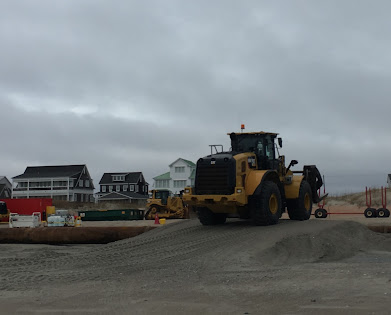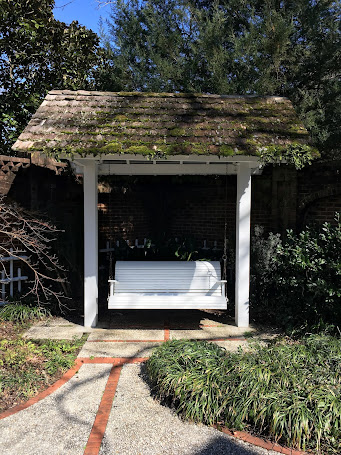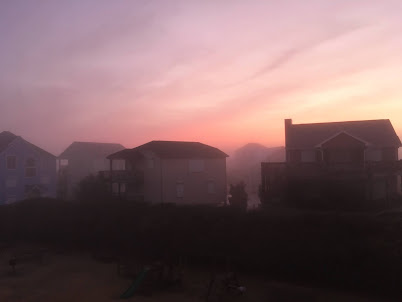We have been experiencing some winter weather here in Atlantic Beach, although in no way as significant
as in other parts of the country where the Polar Vortex is causing real
hardship. We have been especially
watching coverage of Texas
and its power and water outages. Having
experienced both in the past we can identify with their suffering. We have backup heat at our home in the form
of gas logs in our fireplace (replacing the wood-burning fireplace insert we
had for three decades) and a generator that stands at the ready in the basement
with plenty of fuel, but not everyone has those advantages.
Tuesday morning brought a small miracle in the midst of the
wind and rain and cold, an unexpectedly balmy 67-degree day. We decided it would be a good day to drive to
New Bern less than an hour away and visit the Tryon Palace
gardens, which has been on our limited list of things to do in these times
where most events have been cancelled due to Covid. We packed a picnic lunch, and as we were
preparing to leave, a bright fog materialized from nowhere. It burned off by the time we reached Havelock, and was
replaced by clear blue sky and sunshine - a welcome sight!
We arrived at the Visitor’s Center, one of the nicest we
have seen anywhere and home to the annual “Winterfeast” festival beloved of
oyster connoisseurs, which we have attended in past years. The helpful volunteer who sold us our tickets
to the gardens also directed us toward a good place for a picnic, a small
garden behind the Commission House just across from the Palace. “There’s a little arbor and a swing over in
the corner.” Her directions were remarkable
accurate.
We sat in the swing under the moss-covered roof and ate our tuna sandwiches and soaked
up the warmth. The Commission House,
which serves as the administrative offices for Tryon Palace,
was built ca. 1886-1888 by Robert B. Lehman and is a lovely, graceful structure
with a transom window over the front door.
I noticed the little sunroom on the east side of the house and thought
it would be a good place for a piano, or perhaps a comfortable chair and a book.
We walked through the garden there and several gardens at
the Stanley House (ca. 1779) across the street which were connected with open
gates. I'm not a fan of boxwoods for the
most part, but they worked well here to separate beds in formal patterns.
Daffodils, crocuses, and hibiscus were all in bloom, which
surprised us because it is only mid-February.
There was a tall cherry tree, too, in full bloom, pink petals
scattered on the brick walkway as if there had been a wedding. The air was heavy and sweet, and I simply
stood beneath it, breathing in the unmistakable perfume of early Spring.
We crossed the street and passed through the big iron gates
of Tryon Palace.
Formerly known as the Governor’s Palace, it was the official residence
and administrative headquarters of the British governors in North Carolina before the revolution. Shortly after the state capital was relocated
to Raleigh in
1792, the main building burned to the ground. A modern re-creation faithful to
the original architect's plans, including the gardens, was built on the site in
the 1950s.
We had toured the palace in previous years but had not had time
to thoroughly see the gardens, so in these times of social distancing this
seemed like a good opportunity. Just
inside the gate, a couple dressed in period costume was working at constructing
barrels, using only hand tools, and we watched them for awhile.
They had a good supply of firewood for mid-February, which
would have been the envy of many suffering families in Texas right now, I thought.
We made our way around to the kitchen garden, which was
producing Brussels sprouts, leeks, and some other winter greens and herbs.
Then we made our way around to the rear of the house and
found this quiet little place, with a round marble roof-less gazebo in the center of a winding path.
Around the other opposite side of the house we found some
walled gardens.
Although there was not
much blooming here in February, they would have been gorgeous in the spring and
summer, and these lovely statues were scattered throughout.
This round structure was close to the house, and it took me
awhile to discovered that it is called a dovecote.
Doves were raised for their meat, and the
guano collected inside the dovecote (which I caught a whiff of as I walked by)
was used for fertilizing the gardens.
Organic
gardeners would approve.
The afternoon was still early, so when we had completed our
tour of the gardens we returned to downtown New Bern just a few blocks away.
In past years we would have enjoyed lunch at
Morgan’s Tavern, but we are still avoiding indoor dining, and even the outdoor
dining on the patio out back seemed a little too crowded for safety, although
there were plenty of unconcerned diners there this afternoon.
I did enjoy wandering Mitchell’s Hardware
next door, though, with its narrow aisles and wooden floors.
While Martha visited some shops, careful to avoid close
contact – she told me later that face mask use was 100% - I walked down to Christ Church,
an architectural and historic gem which I have toured in the past.
It was built as an Anglican Church (it is now
Episcopalian) in 1750 on the foundations of the brick and ballast stone
foundation of Craven County’s first house of worship built here in 1715.
I remembered from a previous tour of the
church that it takes special pride in its five-piece communion service, a gift
of George II in 1752, bearing the Royal Arms.
The sanctuary was closed for a private service today, though, so I was
happy to sit outside under a towering magnolia tree watching squirrels jump
from branch to branch.
There is an
outside worship area on the west side of the church, surrounded by flat marble
grave stones where saints of the church were interred. I would have
enjoyed worshiping there on a summer day.
But
I did the best I could with no liturgy other than the chattering of squirrels
and the squeals of children playing on the nearby playground.
At the end of a long day, we started back to Atlantic Beach, arriving at the condo just before
sunset, giving thanks for this balm of warmth and sunshine in the midst of
winter.







































